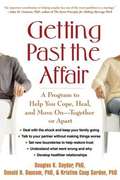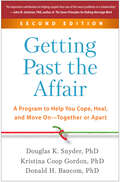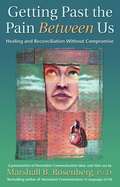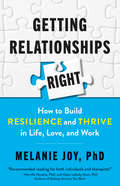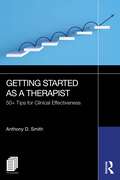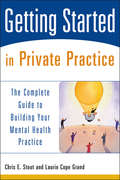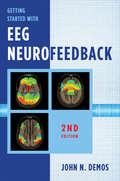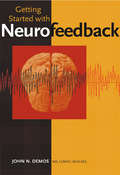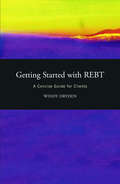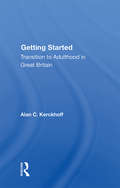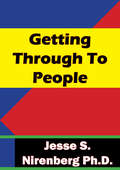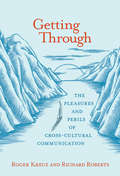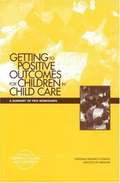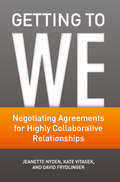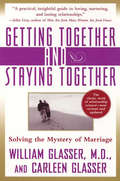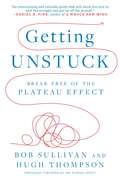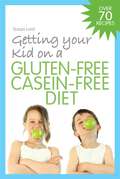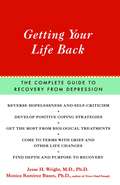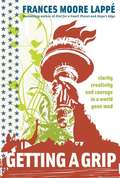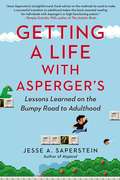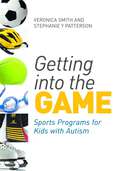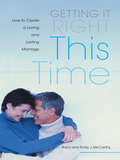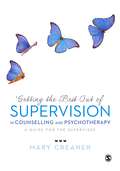- Table View
- List View
Getting Past the Affair
by Donald Baucom Douglas SnyderDiscovering that a partner has been unfaithful hits you like an earthquake. Long after the first jolt, emotional aftershocks can make it difficult to be there for your family, manage your daily life, and think clearly about your options. Whether you want to end the relationship or piece things back together, Getting Past the Affair guides you through the initial trauma so you can understand what happened and why before deciding how to move forward. Based on the only program that's been tested--and proven--to relieve destructive emotions in the wake of infidelity, this compassionate book offers support and expert advice from a team of award-winning couple therapists. If you stay with your spouse, you'll find realistic tips for rebuilding your marriage and restoring trust. But no matter which path you choose, you'll discover effective ways to recover personally, avoid lasting scars, and pursue healthier relationships in the future.
Getting Past the Affair: A Program to Help You Cope, Heal, and Move On--Together or Apart
by Douglas K. Snyder Donald H. Baucom Kristina Coop Gordon"How could my partner have done this?" "What was my role?" "Can this relationship be saved?" Discovering that your partner has had an affair can feel like an earthquake. Long after the first jolt, the emotional aftershocks can make it hard to be there for your family, go about your daily business, and think clearly about your options. Where can you turn for help? From award-winning couple therapists, this compassionate guide has already provided support and expert advice to tens of thousands of readers. Updated throughout, the second edition confronts the myriad challenges facing couples today. Drawing on the latest research, the authors share vivid stories of diverse partners struggling with infidelity in all its forms--sexual or emotional, in-person or online. Learn how to process what happened, cope with anger and mistrust, and map a way to move forward, whether separately or together.
Getting Past the Pain Between Us: Healing and Reconciliation Without Compromise
by Marshall B. RosenbergSkills for resolving conflicts, healing old wounds, and reconciling strained relationships reveal the healing power of listening and speaking from the heart. The tenets of 'Non-Violent Communication' are applied to a variety of settings, including the classroom and the home, in these booklets on how to resolve conflict peacefully. Illustrative exercises, sample stories, and role-playing activities offer the opportunity for self-evaluation, discovery, and application.
Getting Relationships Right: How to Build Resilience and Thrive in Life, Love, and Work
by Melanie JoyBestselling author, psychologist, and relationship coach Melanie Joy shares the principles and tools that can make any relationship, from personal to professional, healthier and more resilient.Relationships are complicated. Yet it's an unfortunate reality that while most of us have to learn complex geometry that we'll probably never use, we don't get a single formal lesson in how to relate to others. In this one-stop guide, psychologist Melanie Joy reveals the common psychological dynamics that underlie all kinds of relationships—with a romantic partner, friends, family members, colleagues—in short, with anyone in any situation. Understanding these dynamics will help you make all your relationships healthier and more resilient. Relationships are like bodies: they get sick when their immune system is weaker than the germs that stress them. Drawing on the most relevant research as well as on her own extensive experience as a psychologist, Joy explains how to strengthen your relational immune system to resist not only interpersonal stressors but also largely invisible yet potentially devastating societal stressors like racism and sexism. With this understanding, you can cultivate relationships that consistently reflect core moral values and honor the dignity of everyone involved. Resilient relationships are not only a source of joy and fulfillment for those who are in them, they also support the thriving of the organizations and communities of which we all are a part.
Getting Started as a Therapist: 50+ Tips for Clinical Effectiveness
by Anthony D. SmithGetting Started as a Therapist provides students and new therapists with a bridge between education and practice. Written for a transtheoretical audience, the book explores questions and struggles common to students and new therapist supervisees. Readers can find pointed guidance in 52 chapters, spanning five categories. Categories include: Establishing better therapeutic relationships. What to avoid saying to patients. Increasing diagnostic accuracy, understanding why diagnosis is not a dirty word, and how it is critical to a good outcome. Specialized topics like how to more effectively talk about self‑injury and learning to use metaphors. Professional development such as making the most of supervision and how to limit liability. The succinct chapters come alive with real‑life examples and are often followed by suggestions for further reading and worksheets that help readers to refine their practice.
Getting Started in Personal and Executive Coaching
by Stout Fairley Stephen G. Chris E.Find satisfaction and financial success with a new career in coaching Getting Started in Personal and Executive Coaching offers a go-to reference designed to help every mental health professional build, manage, and sustain a thriving coaching practice. Packed with hundreds of proven strategies and techniques, this nuts-and-bolts guide covers all aspects of the coaching business with step-by-step instructions and real-world illustrations that prepare you for every phase of starting your own coaching business. This single, reliable book offers straightforward advice and tools for running a successful practice, including: * Seven tools for making a great first impression * Fifteen strategies for landing ten paying clients * Seven secrets of highly successful coaches * Ten marketing mistakes to avoid Complete with sample business and marketing plans and worksheets for setting rates and managing revenue, Getting Started in Personal and Executive Coaching identifies the fifteen biggest moneymaking markets to target and offers valuable recommendations for financing that get the most impact and mileage from every budget. Quick "Action Steps" for applying ideas and techniques make this book useful right away. Get started in coaching today!
Getting Started in Private Practice
by Stout Chris E. Grand Laurie C.All the tips and tools you need to build a successful mental health practice from the ground up Many mental health professionals currently working for group practices, hospitals, and private or government agencies have both the skills and the drive to become solo practitioners. But how and where do you begin? Getting Started in Private Practice is a reliable reference that offers the comprehensive information and armchair motivation you need to establish and build your own practice from the ground up. User-friendly and full of helpful tips, this handy book provides you with tools and techniques for starting and maintaining a thriving private practice, including information on: * Discovering your ideal practice * Creating a business plan * Financing your start-up * Setting fees * Setting up shop and measuring results * Minimizing risk * Managing managed care * Marketing your practice * Generating referrals * Utilizing additional print, Web, and organizational resources From major concerns such as ethics and liability to day-to-day matters like selecting stationery and business cards, Getting Started in Private Practice puts the best solutions at your fingertips. Whether you're a recent graduate or a seasoned pro, this invaluable resource will help you minimize the uncertainty of establishing a solo practice while maximizing the rewards.
Getting Started with EEG Neurofeedback (Second Edition)
by John N. DemosThe long-awaited update to Demos’s classic book for the practitioner looking to add neurofeedback. Neurofeedback training combines the principles of complementary medicine with the power of electronics. This book provides lucid explanations of the mechanisms underlying neurofeedback as well as the research history that led to its implementation. Essential for all clinicians in this field, this book will guide clinicians through the process of diagnosis and treatment.
Getting Started with Neurofeedback
by John N. DemosWhat is neurofeedback? Neurofeedback is founded upon computer technology joined with auxiliary equipment that can measure the metabolic activity of the cerebral cortex. Neurofeedback training combines the principles of complementary medicine with the power of electronics. It is a comprehensive system that promotes growth change at the cellular level of the brain and empowers the client to use his or her mind as a tool for personal healing.Until now, there has not been a single comprehensive yet easy-to-understand guide for clinicians interested in adding neurotherapy to their practice. Getting Started with Neurofeedback is a step-by-step guide for professional health care providers who wish to begin with neurotherapy, as well as experienced clinicians who are looking for a concise treatment guide.This book answers essential questions such as: How does neurotherapy work?, What is the rationale for treatment? When is neurotherapy the treatment of choice? Why should I add it to my already existing healthcare practice? The author also answers questions important to establishing a successful practice such as: What kind of training should clinicians get? What kind of equipment should clinicians buy? How can clinicians add neurofeedback to their existing practice?The first part of the book introduces the reader to the world of neurofeedback, its history and scientific basis. Case studies help clinicians apply what they are learning to their existing practice. Demos takes the mystery out of the assessment process and charts and examples of topographical brain maps (in full color) serve as teaching aids. Later in the book, advanced techniques are explained and demonstrated by additional case studies. The reader is shown how to use biofeedback for the body to augment neurofeedback training as well as being taught to work with the body and acquire a basic knowledge of complementary medicine.The book concludes by offering clinicians practical suggestions on marketing their expanded practice, purchasing equipment, finding appropriate training and supervision, and keeping up with the ever-growing profession of neurofeedback. Research and theory unite to demonstrate the clinical underpinnings for this exciting new modality. Some images in the ebook are not displayed owing to permissions issues.
Getting Started with REBT: A Concise Guide for Clients
by Windy DrydenWhat is Rational Emotive Behaviour Therapy? Rational Emotive Behaviour Therapy (REBT) encourages direct focus on emotional problems, encouraging understanding of the thoughts, beliefs and behaviours that are responsible for maintaining these problems. REBT encourages a healthier outlook by teaching individuals to challenge their irrational thoughts. Getting Started with REBT provides a concise guide to assessing the suitability of REBT and using this method to address your emotional problems. The book is divided into two sections, beginning with an introduction to the theory and practice of REBT that will enable the reader to make an informed decision about whether this method is right for them. The second section guides the reader through issues that are relevant to all emotional problems, demonstrating how to: Formulate emotional problems and set goals Question irrational and rational beliefs Strengthen conviction in rational beliefs Getting Started with REBT is suitable for use either alone or in conjunction with work with an REBT therapist. It will also be of interest to therapists and counsellors.
Getting Started: Transition To Adulthood In Great Britain
by Alan C. KerckhoffThis book provides evidence of the significance of a society's structure and normative definitions in giving shape to one part of the life course, examining closely a major period of life course transition, the move from adolescence to adulthood in Great Britain.
Getting Through To People
by Jesse S. NirenbergIf you think you can't reach all the people all the time - think again! Now you can persuade even the most stubborn or hostile audience to see your point of view with these proven techniques from Dr. Jesse S. Nirenberg. Through dozens of anecdotes, you'll learn how to control conversations with emotional people, how to hold other people's attention, and how to decode what people are really trying to tell you. And you'll discover how to reach the most shy and private people and make them want to open up to you. Getting Through to People invites you to join the over 300,000 people using these powerful methods to break through the mental barriers that obstruct true person-to-person communication, and enhance your personal and business success.-Audio ed.
Getting Through: The Pleasures and Perils of Cross-Cultural Communication (The\mit Press Ser.)
by Richard Roberts Roger KreuzUnderstanding how culture affects the ways we communicate—how we tell jokes, greet, ask questions, hedge, apologize, compliment, and so much more.We can learn to speak other languages, but do we truly understand what we are saying? How much detail should we offer when someone asks how we are? How close should we stand to our conversational partners? Is an invitation genuine or just pro forma? So much of communication depends on culture and context. In Getting Through, Roger Kreuz and Richard Roberts offer a guide to understanding and being understood in different cultures. Drawing on research from psychology, linguistics, sociology, and other fields, as well as personal experience, anecdotes, and popular culture, Kreuz and Roberts describe cross-cultural communication in terms of pragmatics—exploring how language is used and not just what words mean. Sometimes this is easy to figure out. If someone hisses “I'm fine!” though clenched teeth, we can assume that she's not really fine. But sometimes the context, cultural or otherwise, is more nuanced. For example, a visitor from another country might be taken aback when an American offers a complaint (“Cold out today!”) as a greeting. And should you apologize the same way in Tokyo as you would in Toledo? Kreuz and Roberts help us navigate such subtleties. It's a fascinating way to think about human interaction, but it's not purely academic: The more we understand one another, the better we can communicate, and the better we can communicate, the more we can avoid conflict.
Getting To Positive Outcomes For Children In Child Care: A Summary Of Two Workshops
by Board On Children Families YouthA summary on Getting To Positive Outcomes For Children In Child Care
Getting To We
by Kate Vitasek Jeanette Nyden David FrydlingerDrawing on best practices and real examples from companies who are achieving record results, Getting to We flips conventional negotiation on its head, shifting the perspective from a tug of war between parties to a collaborative partnership where both sides effectively pull against a business problem.
Getting Together and Staying Together: Solving the Mystery of Marriage
by William Glasser Carleen GlasserThe facts are nothing short of startling--no matter how many people seem to walk down the aisle, the divorce rate in America is at a record high. What's the secret to getting into a happy marriage and, even more important, staying in one? Now world-renowed psychiatrist Dr. William Glasser and his wife, Carleen Glasser, update their classic guide to successful marriages, Staying Together, for couples young and old. As they examine the questions of why some marriages work and others fail, the Glassers advise readers on how to create loving and happy relationships by applying Dr. Glasser's trademark "choice theory." The result is a wealth of new information about who would make a compatible partner and how to improve any relationship.
Getting Unstuck: Break Free of the Plateau Effect
by Bob Sullivan Hugh ThompsonJust try harder. Just work harder. Just do more. But what happens when working harder doesn't seem to be getting you better results? You've got to get unstuck. In Getting Unstuck, Bob Sullivan and Hugh Thompson show the different kinds of plateaus that can hold you back and how they can be overcome. Using case studies of both success and failure--including Derek Jeter, Blockbuster, and Google--they identify how to avoid pitfalls and to incorporate the peak behaviors that place breakthroughs within anyone's grasp. If you've ever given more and more to a broken relationship, a weight-loss regimen, or a stalled career--only to get less and less in return--Getting Unstuck will change your life.
Getting Your Kid on a Gluten-Free Casein-Free Diet
by Susan LordGluten-free casein-free diets are widely used to improve cognitive function, speech patterns, behavior, and general well-being in children on the autistic spectrum. Written by a registered dietician and mother of a child who is thriving on a gluten-free casein-free diet, this practical guide covers everything from how to get your child on the diet, to daily meal plans, recipes and handy shopping lists. Susan Lord offers sound nutritional advice on how to implement the diet correctly, without harming your child by omitting major nutrient groups. Whether you are a parent or care-giver, this book will make removing gluten and casein from an autistic child's diet simple and stress-free. The easy-to-follow meal plans, complete with delicious recipes and ingredient lists, will guide you with confidence in providing a nutritionally-balanced diet for your child, as well as healthy meals the whole family will enjoy.
Getting Your Life Back
by Monica Ramirez Basco Jesse WrightIn this powerful new self-help program, Wright and Basco show you how to blend the best methods of scientifically tested treatments to win the battle against depression. By following their step-by-step instructions, you will be able to develop a Personal Plan for Recovery that you can use to get well and stay well. The flexible plan lets you learn about and master the Five Keys to Recovery in the sequence that's best for you. Some people may want to work through all five keys; others may find they are able to achieve the level of health they want with just a few. Whether you learn the self-help strategies of cognitive-behavior therapy, rely on prescription antidepressants, try herbal remedies, work on mending relationships, focus on spiritual growth, or use a combination of methods, the Personal Plan for Recovery is a breakthrough tool that allows you to take control of your own treatment. Conversational and filled with guided exercises and strategies that work, Getting Your Life Back is an empowering book that maximizes each person's strengths and potential.
Getting a Grip: Clarity, Creativity, and Courage in a World Gone Mad
by Frances Moore LappeThe author breaks the conventions by interweaving fresh insights, startling facts, and stirring vignette of ordinary people pursuing creative solutions to the most pressing global problems.
Getting a Life with Asperger's
by Jesse A. SapersteinHard-won insights on transitioning into adulthood Author, speaker, and autism advocate Jesse A. Saperstein knows a lot about living with Asperger's. Diagnosed at the age of 14, Jesse has struggled, triumphed, flubbed, soared, educated, and inspired. Along the road to adulthood, he has learned many lessons the hard way. In this honest and engaging book, he offers a guided tour of what he's learned about getting along with others, managing emotions, succeeding in school and work, building relationships, and more. Among his Asperger's Rules are: Clean Up Your Own Mess (including but not limited to credit card debt, out-of-control collections, and your cesspool of a room) You Can't Bail Out the Titanic with a Wine Glass (or change the world of online dating) Serving as a Role Model to the Next Generation of Asperger's Syndrome Navigating the challenges of college and the unrelenting storm of transition. The Road to Catastrophe is Paved with Good Intentions (understanding how others perceive you, even if they're wrong) WIN (Work Is Necessary) You are talented enough to maintain employment even if your options are not ideal Confronting Memories of Bullying and Showing Mercy toward Yourself Heartfelt, insightful, and generous, this book will enlighten and inform readers, whether they are on the autism spectrum or not.
Getting from College to Career Third Edition: Your Essential Guide to Succeeding in the Real World
by Lindsey PollakThe third edition of the essential guide for college students and recent graduates to help you prepare for starting your career—now revised and updated for Gen Z to reflect the realities of the current job marketHow do you get a job without experience and get experience without a job? It’s the question virtually every college student and recent graduate faces. With the rise of hybrid work, advances in artificial intelligence, and ever-shifting economic circumstances, the situation for aspiring Gen Z professionals has never been more challenging. But there is help. Getting from College to Career is the definitive guide to building the experience, skills, and confidence you need to tackle today’s fast-moving job search, offering action-oriented tips and strategies ranging from the simple to the expert. Revised with new material, this third edition includes up-to-date advice on how to:Use the best digital and mobile tools— including AI—for career prep and job hunting E-mail, text, and Zoom like a professional Interview in person and virtually Reskill and upskill for “jobs of the future” Manage your mental health through career ups and downs And moreGetting from College to Career gives you the cutting-edge information and guidance you need to get your foot in the door of the real world. Don’t start your first job search without it!
Getting into the Game: Sports Programs for Kids with Autism
by Veronica Smith Shafali Spurling Jeste Stephanie Patterson Janine Halayko Richard K. Spurling Jonathan Rivero Vivian Ng Connie Kasari Laura DumasGetting into the Game: Sports Programs for Kids with Autism Spectrum Disorder will help families, clinicians and coaches support children with autism in taking their first steps into sport and recreation. Participation in individual and team sports plays an important part in children's development and promotes growth in a number of areas. As well as the obvious health benefits, sport also provides the perfect backdrop to teach young people with autism about rules, strategy and teamwork - all invaluable lessons that can be applied to wider society. By detailing six of the most popular sports: cycling, ice skating, swimming, soccer, taekwondo and tennis and including the unique experiences of families of children with autism, it offers all the information, advice and support needed to help get kids with autism engaged in fun and positive sport environments. This book is an invaluable resource for parents, teachers, coaches and anyone supporting children with autism spectrum disorders in a sport or recreation environment.
Getting it Right This Time: How to Create a Loving and Lasting Marriage
by Barry W. McCarthy Emily J. McCarthyAlthough divorce is common, it often holds negative associations. Husband and wife team Barry and Emily McCarthy view divorce and remarriage with optimism, showing it to be a courageous choice that should not be viewed as personal failure but rather as a positive step towards a better life. In Getting it Right This Time, they zoom in on remarriage issues and identify the factors that led to the end of a marriage, using that information to help you learn from past mistakes and start over. Marriage is based on a respectful, trusting relationship, and the McCarthys affirm that remarriage is an important choice that can lead to a rich, rewarding, and loving second chance. Getting it Right This Time provides resources needed to assess and change attitudes, behavior, and feelings to help you build a new marriage and step-family that will bring out the best in you as individuals and as a couple.
Getting the Best Out of Supervision in Counselling & Psychotherapy: A Guide for the Supervisee
by Dr Mary CreanerGetting the Best Out of Supervision in Counselling & Psychotherapy does exactly what it says on the tin! Supervision is an essential part of counselling training and ensuring you know exactly how to get the very most out of supervision is important, whatever their level of study. Exploring how to begin, maintain and end a supervisory learning relationship in the context of existing theory and best practice guidelines, the author will introduce your trainees to: Models and forms of supervision The skills informing good supervision What to expect from supervision Key professional issues in supervision ? Written in a lively and engaging style, this book will enable both supervisors and supervisees to get the best they can from the supervisory experience.
